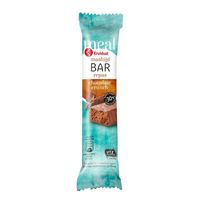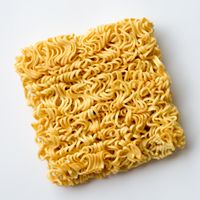Nutrition during a hiking trip: Tips for energetic adventures
A hiking trip offers an unforgettable experience, where you trek through beautiful landscapes and can admire nature in all its glory. But to fully enjoy your adventure, good nutrition is essential. In this blog post, we share useful tips for planning your meals and snacks during a hut-to-hut hike, so you can stay energized and healthy during your trek.
Practical tips for the trail
- Make a meal plan: Plan your meals and snacks in advance, and make sure to bring enough food for the duration of your hut-to-hut hike. Also, always factor in something extra in case the hike or day lasts longer.
- Opt for lightweight food: Avoid heavy and bulky foods and instead opt for lightweight and energy-rich foods that take up little space in your backpack.
- Store food safely: Store perishable foods in airtight containers or bags to prevent spoilage. Also, store food in a cool and dry place to extend its shelf life.
- Ensure a proper balance between sweet and salty foods and choose foods you enjoy so you get enough nutrition.
- Stay hydrated!
Balance between sweet and salty Foods
During physical exertion, it's important to provide your body with the right fuel, which also means replenishing the right nutrients, including sweet and salty ones. Sweet foods, such as carbohydrates, provide quickly available energy that your muscles need to perform. Think of fruit juices, energy bars, or sports drinks. These provide glucose, which can be used directly by your muscles as fuel.
On the other hand, salt is vital for maintaining electrolyte balance in your body, especially sodium. When sweating, you lose not only water but also important electrolytes like sodium, potassium, and chloride. A deficiency in sodium can lead to muscle cramps, fatigue, and decreased performance. Therefore, it's important to consume salty snacks or sports drinks during prolonged exertion to replenish these electrolytes.
Finding the right balance between sweet and salty is essential for optimal performance during physical activity. Too much sweet food can lead to a rapid rise in blood sugar followed by a crash, while too much salt can lead to dehydration and disrupted electrolyte balance. Therefore, experiment with different foods and drinks to discover what works best for your body and activity level. And don't forget to drink enough water to stay hydrated and absorb all nutrients properly.
Hydration is crucial
In addition to nutrition, hydration is also crucial during a hut-to-hut hike. Make sure to drink enough water to stay hydrated, especially during hot weather and intensive hikes. Consider using a water filter or purification tablets to safely drink water from streams and rivers. Additionally, it's recommended to use isotonic tablets in your water. In addition to extra carbohydrates, the electrolytes increase fluid intake.
Snacks for the trail
During a hut-to-hut hike, it's important to bring along nutritious and easy-to-prepare meals. Here are some ideas for meals and snacks that will keep your energy levels up. These snacks are portable, nutritious, and provide a quick energy boost while hiking.
Trail mix: Salted nuts, dried fruit
Salted nuts, such as almonds, cashews, or pistachios, are rich in protein, healthy fats, and fiber. These nutrients provide you with long-lasting energy, allowing you to cover those extra miles without experiencing an energy dip. Moreover, the salt provides a quick source of electrolytes, which is especially handy during intense activities as it helps maintain your hydration balance and prevent cramps.
On the other hand, dried fruit adds a delightful sweet flavor to your snack mix while providing you with natural sugars for immediate energy boosts. Raisins, dried apricots, dates, and cranberries are popular choices due to their portability and nutritional value. They are packed with antioxidants, vitamins, and minerals, making them a valuable addition to your hiking adventure.
Best of all, salted nuts and dried fruit are easy to carry. Put them in a resealable bag or container and toss them into your backpack. That way, you'll always have a nutritious and tasty snack on hand to keep your energy levels up as you enjoy the beautiful nature around you during your hike.
2. Energy bars
Energy bars are a fantastic addition to your nutrition during a hiking trip. They are compact, nutritious, and easy to carry, making them an ideal snack for on-the-go.
Most energy bars are specially designed to provide a balanced mix of macronutrients, such as carbohydrates, proteins, and healthy fats, all of which are essential for delivering long-lasting energy during physical activity. Carbohydrates are particularly important as they provide quick energy for your muscles, while proteins aid in muscle recovery and growth, and healthy fats provide prolonged satiety.
Moreover, energy bars often contain a variety of other nutritious ingredients such as nuts, seeds, dried fruit, oats, and sometimes even chocolate or honey for some extra flavor and sweetness. These ingredients not only provide energy but also important nutrients like fiber, antioxidants, vitamins, and minerals, all of which contribute to a healthy diet and optimal performance while hiking.
Energy bars are also convenient because they have a long shelf life and do not spoil quickly, making them perfect for long hikes or adventures in nature where you may not have access to fresh food. They are easy to carry in your backpack or pocket, and you can quickly grab and eat them at any point during your hike to keep your energy levels up.
3. Chocolate
Chocolate is not only a delicious treat but can also be a useful source of energy and pleasure during a hiking trip. Although it may not seem like the most traditional choice, chocolate has some properties that make it a valuable snack for the trail.
To start with, chocolate contains cocoa, which naturally contains caffeine and theobromine, two substances that can have an uplifting effect. This can be especially useful during long hikes when you need a quick energy boost to combat fatigue.
Additionally, the taste and aroma of chocolate can contribute to an increased sense of well-being and comfort, which can be handy during challenging parts of your journey.
Furthermore, chocolate provides a source of carbohydrates and sugars, which provide quick energy to help you through a tough climb or a long stretch of trail. Dark chocolate also contains antioxidants and flavonoids, which may contribute to healthy blood circulation and reducing inflammation, which can be beneficial for your overall well-being, especially during strenuous activities.
While chocolate is certainly a tasty and convenient snack while hiking, it's important to consume it in moderation, especially if you're sensitive to caffeine or if the temperature is high and there's a risk of melting. Preferably, opt for dark chocolate with a higher cocoa content, as they generally contain less added sugars and offer more health benefits.
4. Meal bars
Meal bars are a convenient and nutritious option for people on the go, including hikers embarking on a long journey. These bars are specially formulated to provide a balanced meal in a portable and easily consumable form.
What distinguishes meal bars from regular snack bars is their nutritional density and composition. They are often enriched with a mix of macronutrients such as carbohydrates, proteins, and healthy fats, making them a complete meal replacement. This makes them ideal for situations where it's difficult to prepare or consume a traditional meal, such as during a long hike where you may not always have access to a kitchen or restaurants.
A typical meal bar may contain ingredients like oats, nuts, seeds, dried fruit, protein powder, and other nutritious ingredients. These ingredients not only provide energy but also essential nutrients like fiber, vitamins, and minerals that your body needs to function properly, especially during physical activity.
Another advantage of meal bars is their convenience. They are compact, lightweight, and do not require refrigeration, making them perfect for on-the-go consumption. Additionally, they are often individually packaged, making them easy to portion and less likely to spoil or spill in your backpack.
While meal bars are convenient, it's important to note that they are not a substitute for fresh, whole meals in the long term.
5. Salty crackers
Salty crackers are beloved for their simple yet satisfying taste and their convenient portability, making them a popular choice for on-the-go snacking, including hiking trips.
What makes salty crackers appealing to hikers is their lightweight nature and longer shelf life, making them easy to carry and requiring no refrigeration. This makes them a practical option for longer hikes or treks where immediate access to fresh food may not be available.
While salty crackers are often considered a "basic" snack, there are now many varieties available that are enriched with fiber, whole grains, and other nutritious ingredients. These variants offer more nutritional value than traditional white flour crackers and can serve as a good source of carbohydrates and fiber during physical activity.
Another advantage of salty crackers is their versatility. They can be enjoyed as they are or paired with other ingredients such as cheese, hummus, nuts, or dried fruit to create a more filling and nutritious snack. These combinations provide a mix of carbohydrates, proteins, and healthy fats that provide energy and keep you satisfied during your hiking adventures.
6. Sausage snacks
Sausage snacks are small, portable meat products beloved for their savory taste and easy portability, making them a popular choice for on-the-go snacking, including hiking trips.
These sausages are typically made from minced meat, such as pork, beef, chicken, or a combination thereof, seasoned with various spices and then smoked, dried, or cooked. They are available in various sizes and varieties, including cocktail sausages, mini salamis, and slim sausages.
What makes sausage snacks appealing to hikers is their longer shelf life and portability. They are easy to carry in a bag or container and do not require refrigeration, making them a practical option for longer hikes or treks where access to fresh food may not be available.
The salt provides a quick source of electrolytes, which is especially handy during intense activities, as it helps maintain hydration balance and prevent cramps.
While sausage snacks are often considered an "unhealthy" snack due to their fat and salt content, they can still have a place in a varied diet, especially during physical activities such as hiking. They provide a source of protein and fats that provide long-lasting energy and help keep you satisfied during your outdoor adventures.
7. Instant noodles
Instant noodles can be a smart choice as a snack during a hiking trip for several reasons. Firstly, they are portable and easy to carry, especially the packaged instant noodles that do not require refrigeration. This makes them ideal for outdoor activities where you want to travel light.
Additionally, instant noodles are a quick and easy source of carbohydrates, which are essential for providing energy during a hike. The carbohydrates in the noodles are rapidly broken down and converted into energy, helping to prevent fatigue and maintain performance levels.
Furthermore, many instant noodles also contain salt and other electrolytes, which are important for maintaining proper hydration and preventing dehydration during physical activity. This is especially crucial during hot weather or intense exertion where you may sweat a lot.
Another advantage of instant noodles is that they can be eaten warm, providing extra comfort and warming your body on a cold day. Adding vegetables or protein to the noodles can also provide additional nutrients and flavor.

.jpg/picture-200?_=18df9a87ba8)





